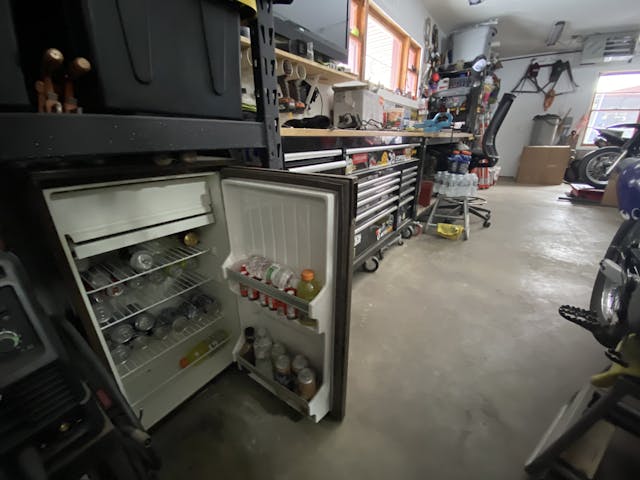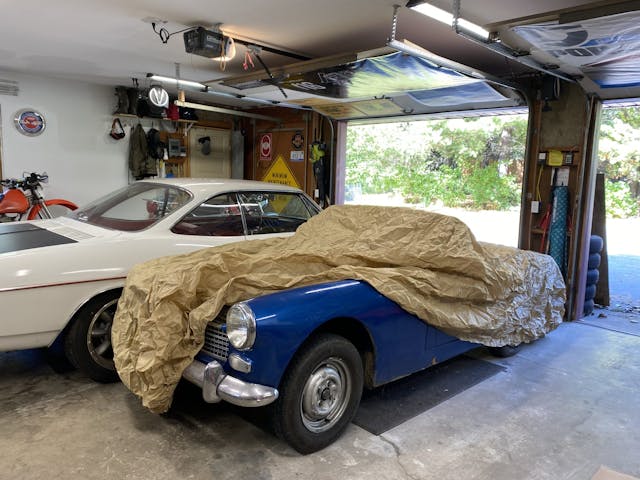4 Things Silently Killing Your Vintage Car
You click the ignition key one detent to the right. A quick twitch of the right foot to tickle the accelerator pump and set the choke. Another touch on the key and . . .
Nothing.
What should be a crescendo of eight trumpets playing the V-8 version of taps and stirring the car person’s soul awake is instead the painful silence punctuated by the soft click of the ignition cylinder returning to the off position. Wake up, it’s just a nightmare.
At least, for now it is. It could happen to you, though. Nature is a cruel mistress who is conspiring against us and our cars and doing so both vigorously and silently. Here are four main offenders to keep your eye on, since your ears aren’t going to help.
The Garage Fridge

Current moving around inside an electric motor—like the compressor of a refrigerator—produces ozone, and that combined with sunlight can age tires and other rubber parts very rapidly. Replacing dry-rotted but otherwise fine parts gets expensive and annoying very quickly. If you are like me and aren’t ready to give up the fridge or freezer, focus on keeping sunlight away from your vintage ride.
Corrosion

Deep inside your car, there is a war being waged between materials and nature. Hate to break it to you, but nature always wins. That means rust and other types of corrosion are leeching into the metals and connections that not only shape your car but also make it functional and easily serviceable. For every joke about “hearing a car rust” there are five cars that rusted away before the owner even noticed.
Being Parked

Sitting is the last thing cars were designed to do. All of the silent killers, and a few of the noisy ones, attack when the car is laying dormant. These things gain ground while the car is waiting, only for us to claw back some ground with our occasional drives. Oil coatings slip off and leave dry-start conditions inside an engine that could drive an owner to doing the extra work of priming an engine just to go driving. That’s only for those who are both aware and care enough to take that action. For many, ignorance is bliss when turning the ignition key and hearing the rumble through the exhaust pipes.
Friction

Fine, I’ll concede this one is not always silent, but with or without noise, excess friction is making your vintage car smaller with every drive. I’m not even talking about the intentional friction from brake or clutch lining, but instead about the metal-to-metal contact that was never designed to be that way. Grease and oil are subject to gravity just like us, so keeping oil and grease in the right spot is a never-ending task as they silently slide and ooze past seals and gaskets. One small drop on the garage floor might not seem like a big deal but over time can mean lots of very worn-out parts that seemingly happened out of nowhere.



I’ve known people that did that and the exhaust eventually turned into lace. Running only for 15 – 30 seconds is just enough time for the exhaust to get warm and humid on the inside and not hot enough to evaporate all the moisture. It just sits there and rusts away. I do leave the hood up though. It also extends the life of the hood struts, if it has them, by not leaving them in a compressed position.
I am 65 and living with 16 electrodes along my spinal cord, wired to an implanted Spinal Cord Stimulator, and a liquid opiate pain pump plumbed into my veins 24/7…. BUT, my amazing wife takes me out a few times each summer in our hand built 2012 Grand Prix Edition LOTUS Evora S with me fully reclined in the passenger seat, for a short rip down the country roads with the exhaust singing a 7,200rpm (muffler delete) song! What a special woman who drives a Lotus as it should be driven, just for me to forget the pain for those few minutes at speed!
LOTUS Evora S GP (1 of 25 worldwide)
1938 Lancia Aprilia “Speciale” (1 of 1)
1965 Formula V (Porsche) (1 of 31)
1996 FIAT Barchetta (imported)
1999 SLK 230 Kompressor
2022 Subaru Outback “Wilderness”
I am amazed that you would put out an article like this and never fact check the nonsense
Point 1. A residential refigeration system in ANY fridge built in at least 40 years or more uses refrigerants that are always under pressure and the system is hermetically sealed, so the motor is never exposed to room conditions ! To make that statement is essentially dumb! I stopped reading the article!! If homework was t done on item 1 why would one read on?
I did a 4 year DIY resto on my 69 XKEOTS. I primed everything before start-up and EVERYTHING leaked oil, but especially the rear main (rope) seal. It didn’t straighten out until I took a long trip and blew 3 qts. of oil through that rear seal. That was enough to “wet” the seal and make it work properly, I now drive it at least once every two weeks and there are no longer Exxon Valdez oil spills on my garage floor.
It’s a different problem with my two Porsches with horizontally opposed six cylinder engines. If they are not driven at least every two weeks, the oil slowly seeps away from the tops of the cylinders, possibly causing the dreaded bore score.
Gotta drive these things or sell em. BTW, I’m turning eighty in November. Yes, my eyesight is failing and yes, I’m likely to put all three of these gems up for sale in the not too distant future. I’m stubbornly resisting,
I’ve got a 95 impala which sits around but I run synthetic oils, with a k and n oil filter. Currently has a mysterious coolant leak but I suspect it’s an heater line or the heater core itself
All refrigerators’ compressors are hermetically sealed and do not release ozone into the atmosphere. Larger 2+ door refrigerators may have fans to move air from the freezer section to cool the refrigerator compartment. Those would produce/release ozone, but a typical garage fridge is single door (as in the photo).
Rainex waterless cleaner works for me,on car body and glass. No water,no rust. 10 bucks per spray bottle at Walmart. May be able to order in bulk quantities on line. All tires: get rid of them at 7 year age, also the valve stems. Moth balls ok in limited use, but naphthalene gas emitted and is flammable and toxic. Boom!!
Leaving a car under a cloth cover outside also presents an issue. Moisture heated by the sun will bubble the paint. I learned this by covering my 72′ TVR Vixen.
Correct, car covers are the worst thing you can do for a car. They always trap moisture I don’t car how many dollars you spend or how “great” the material is. My trans am for destroyed by a car cover from the PO. At 66,000 miles, it looks like it has 500,000 miles and sat on the bottom of a salt lake bed for 20 years.
Yup, cars are built to drive them. When shopping for a 50+ year old car, I cringe at 10,000 mile or less cars. The transmission clutches are dried up an will probably come apart after the next burnout. Cylinder walls get rusty in the cylinders with their exhaust or intake valve open. I recommend a solid 30 mile ride once a week to drive the moisture out of the engine and replace the engine oil at least once a year with a good quality zinc oil. Brake fluid flush every 2 years, coolant change every 5 years. Driving the car that much will get the fuel tank empty every 2 months and fill with fresh ethanol fuel and keep the carburetor clean. Yes, you can vacuum seal the car and help it not self destruct, but you can’t stop it. It’s a car, drive it and make memories with it. It’s gonna get road damage? Yup, it may happen. I see many $70,000 cars with a dent or chip in the paint. Car ownership is about that too.
It is with very mixed feelings that I read comments from people who want to keep on like it was 20yrs ago but age and challenges of life keep us from doing things the way we used to. I have lived that challenge in my own life and after major surgery to rebuild a part of my frame find everything takes a wee bit longer and the days and weekends aren’t long enough to get out and drive the antiques regularly or find the energy to get into the next restoration and these days shop rates have climbed to the point paying others is hard to accept. There is a hope we can inspire the next generation to carry on our hobby but wouldn’t it be nice if we could let them get behind the wheel at 18 if we were sitting beside them and still be OK with knowing Hagerty had our backs as we try and raise a generation with appreciation and respect of the history we try and keep rolling. Our future daughter in law wants to see the 89YJ out of the barn and at the beach and has asked for the 31Model A to drive her to the wedding next fall so I couldn’t be happier we are welcoming an enthusiast to the family, I just hope she is willing to turn a few wrenches and help with the maintenance.
Absolutely agree just sitting is the worst thing for a classic, brakes and hoses fall apart so quick when they sit, fuel doesn’t last and it takes so much extra effort to get them rolling if you don’t have them out regularly. Unfortunately the pages of the calendar sometimes turn faster than the wheels do.
Residential freezers and refrigerators have electric motors sealed in the compressor. No ozone gets out. If it has a condenser fan that can be an ozone source.
The condenser fan in a refrigerator is typically a shaded-pole AC motor, which has no commutator or brushes. Shaded-pole AC motors can’t emit ozone; motors with brushes and commutators certainly can and do.
I didn’t realize that there were so many of us old foggies who still love their favorite oldie. I’ll be 73 this month and found an ’86 Fiero GT a couple years ago with 18k original miles, in near showroom condition. Had bought a new one in ’87, and have wanted another ever since selling it in 1990. Like clockwork, after finding this one, my health hit the skids. COPD, Degenerative Disk Disease, and heart disease. Now, I’m kinda prepping it for BAT or Haggerty. Sad times.
Refrigerator motors do not produce ozone that can be emitted into the air in a room. They are completely sealed inside the compressor housing so they can drive the refrigerant pump, which is necessary for the refrigeration cycle to work. If refrigerators produced ozone, don’t you think that they would have warning labels about this hazard plastered all over them? Sorry, but this claim is completely wrong.
I’d like to add one thing to the preservation of our car collections. To combat concrete porosity I installed a vapor barrier during the pouring my garage floors. A simple sheet of plastic on the pea gravel under the wire. The cement contractor didn’t like it as he had to be more careful during the pour. My 1983 Porsche 944 bought new has absolutely no corrosion on the aluminum engine components and my 1965 Pontiac survivor from California enjoys the dry climate unlike the humid Chicago summers.
It’s not Taps! It’s Reveille
At ease.